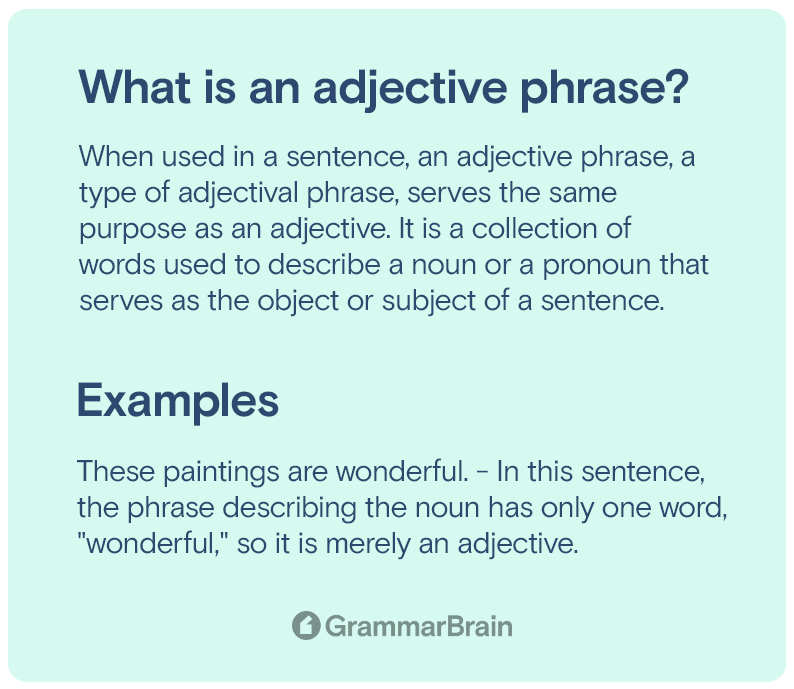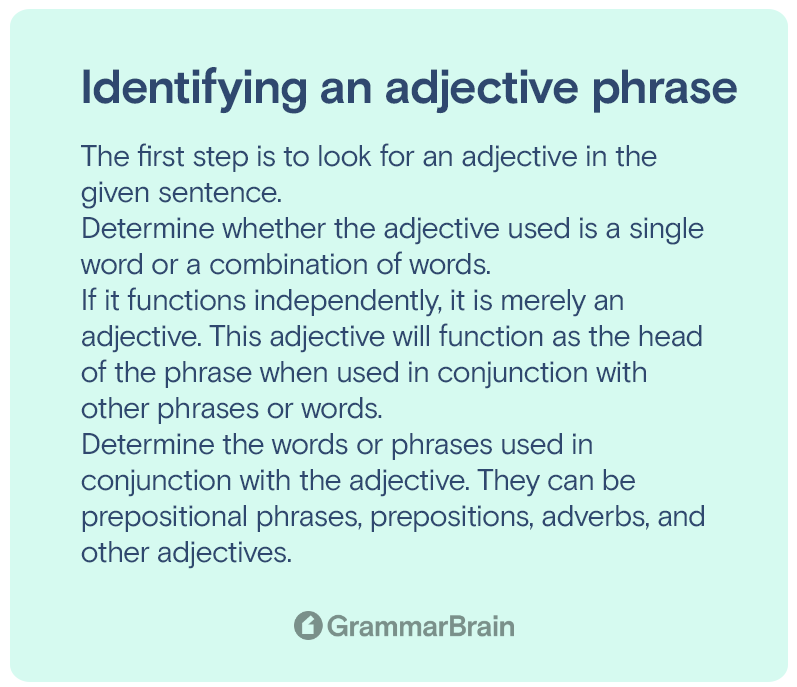What is an adjective phrase? How does an adjective phrase work? When used in a sentence, an adjective phrase, a type of adjectival phrase, serves the same purpose as an adjective. It is a collection of words used to describe a noun or a pronoun that serves as the object or subject of a sentence.
Adjective phrases always have an adjective functioning as their head. They may also include phrases or words after or before the head, like complements and modifiers. The head can be placed at the beginning, end, or middle of the phrase.

Adjective phrases – examples
Consider the examples given below. The adjective phrases in each sentence are written in bold.
- These paintings are wonderful. – In this sentence, the phrase describing the noun has only one word, “wonderful,” so it is merely an adjective.
- Jenna is a really beautiful girl. – In this sentence, the adjective phrase has the adjective “beautiful” and the modifier “really” before it.
- The couch was comfortable enough. – In this sentence, the adjective phrase has the adjective “comfortable” and the “modifier” enough after it.
- Some boarders are not willing to eat the food cooked in the hostel. – In this sentence, the adjective phrase has a complement phrase that completes its meaning along with the head adjective.
- Alex was extremely interested in pop music. – In this sentence, the adjective phrase has an adjective, a modifier before it, and a complement.
Types of adjective phrases
The different types of adjective phrases include:
Attributive adjective phrases
The distinguishing feature of attributive adjective phrases is that they appear inside the noun phrase they are modifying. They typically precede the noun they modify.
Examples:
- The book contains extremely convoluted phrases.
- The skillfully carved statues are invaluable.
- Jenna, faster than Judy, was selected for the college athletic meet.
- Lily bought a very flashy yet quite cheap dress.
Even though attributive adjective phrases generally precede the noun, there are some cases where they appear after the noun. Here the characteristic considered is whether it appears outside or inside the noun.
Example:
The statues skillfully carved by Michelangelo are invaluable.
Predicative adjective phrases
The distinguishing feature of predicative adjective phrases is that they appear outside the noun phrase they modify. They typically appear after a connecting verb and also follow the noun they modify.
Examples:
- The book is not extremely convoluted.
- The statues are skillfully carved and invaluable.
- Jenna is faster than Judy.
- The dress is very flashy yet quite cheap.
Point to note:
Both attributive and predicative adjective phrases can be used in the same sentence.
Example:
The cat, covered in sprinkles, looks satisfied with herself.
In this sentence, “the cat” is the noun, and the adjective phrase “covered in sprinkles” comes after it. But this adjective phrase is attributive since it is inside the noun phrase. The adjective phrase “satisfied with herself” is predicative. It is connected to the noun using the verb look and appears after it.

Steps for identifying adjective phrases
Identifying adjective phrases means identifying phrases or words that describe a noun or a pronoun in a given sentence.
- The first step is to look for an adjective in the given sentence.
- Determine whether the adjective used is a single word or a combination of words.
- If it functions independently, it is merely an adjective. This adjective will function as the head of the phrase when used in conjunction with other phrases or words.
- Determine the words or phrases used in conjunction with the adjective. They can be prepositional phrases, prepositions, adverbs, and other adjectives.
More detail on how to identify an adjective phrase (in-depth)
Do you wish to find an adjective phrase in a particular sentence? Locate the noun or pronoun first. Try to identify what or who the sentence is all about. And work your way from there. Here is an example to understand this concept better.
- After hunting around for several months, Joseph found a dependable, yet affordable, used vehicle.
If you look carefully, the above sentence has two nouns: the vehicle and Joseph. You have to locate now adjectives, which are words that describe these nouns. In the sentence here, the vehicle is the only noun that is described – it’s a used vehicle.
However, when you look closely, you will realize that it is not only a used vehicle but rather a dependable, yet affordable, used vehicle. The phrase “dependable, yet affordable, used” is the adjective phrase here. That’s because the phrase offers descriptive information about the noun “vehicle.”
It is true this adjective phrase could have been deleted, and the meaning of the sentence would remain the same. “After hunting for several months, Joseph found a used vehicle.” However, by using the entire phrase, we are describing the exact vehicle type in detail.
Locating phrases that aren’t vital
Try to locate phrases, which could be cut from the sentences, but their meanings would stay the same. Adding them would mean offering valuable context. Check out some more adjective phrases below in bold to serve this function.
- The dog’s huge, menacing eyes state that a conflict is imminent.
- She did not enjoy reading the book as it was excessively long and complex for her to follow.
- Their cluttered ‘80s-era drawing room desperately requires an update.
Issues when using adjective phrases
A predicament that many authors face while using adjective phrases is whether to employ a hyphen or not, like “professionally-skilled writer” or “professionally skilled writer.” The general rule of thumb is to not use the hyphen.
When the adjective in a sentence is modified using an adverb that ends in “-ly”, it is better to avoid the hyphen. But in some cases, the adverb may look like an adjective like “better,” “best,” “well,” or “fast.” In this case, use the hyphen to prevent ambiguity.
Why adjective phrases are important
One of the key benefits of using adjective phrases in sentences is that they go well with nouns or pronouns. These phrases add to or change their meanings.
While we use adjectives for describing nouns, adjective phrases are used for describing adjectives.
Eventually, adjective phrases help to create richer sentences and offer vivid descriptions for pronouns or nouns.
Understanding multi-word adjectives
A multi-word or compound adjective includes more than one individual word. Typically, these words are connected by hyphens or a hyphen if used as adjectives. For instance, happy-go-lucky and absent-minded are some multi-word adjectives.
Apart from the convention of using hyphens, multi-word adjectives function in the same manner as other adjectives. These adjectives are also used for modifying/describing pronouns and nouns. They frequently appear before words, which they describe in sentences.
Sometimes, writers may not include hyphens while using a multi-word adjective. Rather, these people may use italics or question marks to indicate they are using several words together as multi-word adjectives.
For instance:
Many people disliked Gorgie and her “holier than thou” self-portrayal.
It is imperative to note that proper nouns are sometimes placed without hyphens as multi-word adjectives. These words use capital letters instead of hyphens.
For instance:
- The film gave a feel of the Lord of the Rings to the audience.
- They went to the We Will Rock You concert.
Check out some more instances of a compound or multi-word adjectives below:
- Wishy-washy, double-sided, 500-word, top-of-the-line, fat-free, seven-hour, Spanish-speaking, never-ending, gender-neutral, middle-aged, born-again, out-of-the-way
Exercise on adjective phrases
Now that adjective phrases have been discussed in detail, use the practice assignment provided below to assess your understanding of adjective phrases. From the sentences given below, find the adjective phrases:
- The girl in the green dress is new in town.
- Are you taller than your sister?
- The blue-eyed British manager charmed all the investors in very little time.
- The man with the large bag was apprehended by the police.
- Is the violin on the chair yours?
- Can you bring me a carton of low-fat milk when you go shopping this evening?
- Which one of these dishes do you think is the tastiest?
- The manager was expecting a very high turnover this Christmas season.
- The small Victorian townhouse is one of the oldest buildings in the village.
- All the members of my family held hands and quietly cried during the funeral.
What is an adjective prepositional phrase?
Phrases are groups of words that qualify the pronouns or nouns. A phrase functioning as an adjective in a sentence is an adjective prepositional phrase. However, such a phrase should have a proposition before it. The following are some examples of adjective prepositional phrases with explanations:
- John is in a danger and is making attempts to come out of it.
In the above sentence, the noun “John” is being referred to as “in a danger” by the phrase.
- The building in front of the school is ours.
“In front of the school” is an example of an adjective prepositional phrase, which includes more information about “The building.”
- Bryan, beside her is a professor of French.
In this sentence, the phrase “beside her” describes the noun “Bryan.” “Besides her” is an example of an adjective prepositional phrase.
FAQs
Are adjective and adjectival phrases the same?
Adjective phrases and adjectival phrases are not quite the same. Any phrase that serves as an adjective in a sentence is termed an adjectival phrase. Whereas for a phrase to be an adjective phrase, the head or main word in the phrase should be an adjective. This makes adjective phrases a subset of adjectival phrases.
How does an adjective phrase improve a sentence?
Appropriate adjective phrases can add more life, spice, and personality to any sentence. These phrases describe the subject at hand in detail, giving the readers a clear picture of what is being described in the text. Thus, adjective phrases can help writers create sentences that promote better understanding.
Is there any difference between adjective phrases and adjective clauses?
Both these phrases describe a noun or a pronoun. Adjective phrases contain adjectives and other words like complements and modifiers. Whereas adjective clauses are made up of a verb and relative pronouns.
Example:
Adjective phrases
The man, from China, was elected as the President of the conglomerate unanimously by the board members.
Adjective clauses
The man, who is from China, was elected as the President of the conglomerate unanimously by the board members.
What is an attribute adjective phrase?
The key characteristic of an attributive adjective phrase is that it appears inside the noun phrase that it modifies.
What are examples of a predicative adjective phrase?
An example sentence is, “Sam ordered a very spicy but quite small pizza.”
Sources:
- Wikipedia – Adjective phrase
- Cambridge Dictionary – Adjective phrases
- Wiktionary – adjective phrase
- Collins Dictionary – Adjective phrase definition and meaning
Inside this article
Fact checked:
Content is rigorously reviewed by a team of qualified and experienced fact checkers. Fact checkers review articles for factual accuracy, relevance, and timeliness. Learn more.
Core lessons
Glossary
- Abstract Noun
- Accusative Case
- Anecdote
- Antonym
- Active Sentence
- Adverb
- Adjective
- Allegory
- Alliteration
- Adjective Clause
- Adjective Phrase
- Ampersand
- Anastrophe
- Adverbial Clause
- Appositive Phrase
- Clause
- Compound Adjective
- Complex Sentence
- Compound Words
- Compound Predicate
- Common Noun
- Comparative Adjective
- Comparative and Superlative
- Compound Noun
- Compound Subject
- Compound Sentence
- Copular Verb
- Collective Noun
- Colloquialism
- Conciseness
- Consonance
- Conditional
- Concrete Noun
- Conjunction
- Conjugation
- Conditional Sentence
- Comma Splice
- Correlative Conjunction
- Coordinating Conjunction
- Coordinate Adjective
- Cumulative Adjective
- Dative Case
- Determiner
- Declarative Sentence
- Declarative Statement
- Direct Object Pronoun
- Direct Object
- Diction
- Diphthong
- Dangling Modifier
- Demonstrative Pronoun
- Demonstrative Adjective
- Direct Characterization
- Definite Article
- Doublespeak
- False Dilemma Fallacy
- Future Perfect Progressive
- Future Simple
- Future Perfect Continuous
- Future Perfect
- First Conditional
- Irregular Adjective
- Irregular Verb
- Imperative Sentence
- Indefinite Article
- Intransitive Verb
- Introductory Phrase
- Indefinite Pronoun
- Indirect Characterization
- Interrogative Sentence
- Intensive Pronoun
- Inanimate Object
- Indefinite Tense
- Infinitive Phrase
- Interjection
- Intensifier
- Infinitive
- Indicative Mood
- Participle
- Parallelism
- Prepositional Phrase
- Past Simple Tense
- Past Continuous Tense
- Past Perfect Tense
- Past Progressive Tense
- Present Simple Tense
- Present Perfect Tense
- Personal Pronoun
- Personification
- Persuasive Writing
- Parallel Structure
- Phrasal Verb
- Predicate Adjective
- Predicate Nominative
- Phonetic Language
- Plural Noun
- Punctuation
- Punctuation Marks
- Preposition
- Preposition of Place
- Parts of Speech
- Possessive Adjective
- Possessive Determiner
- Possessive Case
- Possessive Noun
- Proper Adjective
- Proper Noun
- Present Participle
- Prefix
- Predicate



